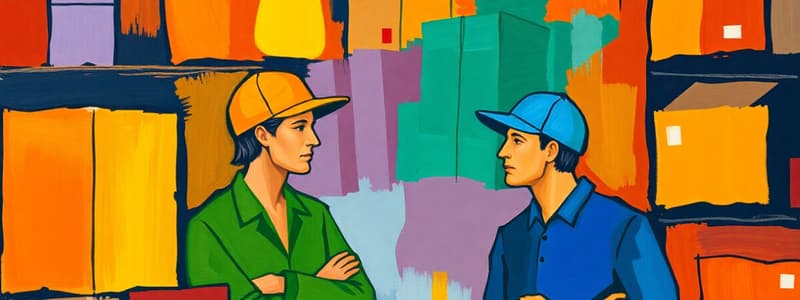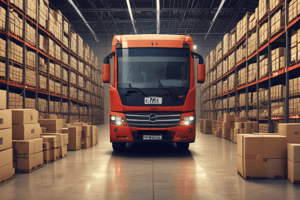Podcast
Questions and Answers
What is the primary goal of the logistics plan as stated in the goal statement?
What is the primary goal of the logistics plan as stated in the goal statement?
- Ensuring dispatch compliance with minimal costs (correct)
- Maximizing the cost of dispatches
- Enhancing marketing and sales effectiveness
- Increasing production planning efficiency
Which of the following stakeholders is NOT explicitly mentioned in the logistics stakeholders section?
Which of the following stakeholders is NOT explicitly mentioned in the logistics stakeholders section?
- Marketing and Sales Team
- Transport Partners
- Production Planning
- Quality Control Team (correct)
What is a potential benefit of using diverse transport partners in logistics?
What is a potential benefit of using diverse transport partners in logistics?
- Elimination of third-party logistics services
- Increased flexibility in product distribution (correct)
- Reduced capital investment in all transport assets
- Simplified communication among stakeholders
In the context of logistics material movements, which location serves as the initial departure point for goods?
In the context of logistics material movements, which location serves as the initial departure point for goods?
Which of the following aspects is NOT a focus area of the logistics as outlined in the content?
Which of the following aspects is NOT a focus area of the logistics as outlined in the content?
What is the customer's responsibility regarding transportation under EXW terms?
What is the customer's responsibility regarding transportation under EXW terms?
Which cost component includes charges for loading, unloading, and moving resources?
Which cost component includes charges for loading, unloading, and moving resources?
In which situation would the logistics team assume responsibility for transportation?
In which situation would the logistics team assume responsibility for transportation?
What is a factor determining the freight class for steel resources?
What is a factor determining the freight class for steel resources?
What is the purpose of unitization cost in logistics?
What is the purpose of unitization cost in logistics?
What does the lead time of delivery refer to in outbound logistics?
What does the lead time of delivery refer to in outbound logistics?
Which of the following surcharges is applicable for both steel and billet freight classifications?
Which of the following surcharges is applicable for both steel and billet freight classifications?
What does ERS stand for in the context of delivery logistics?
What does ERS stand for in the context of delivery logistics?
Which of the following movements does NOT involve HSM as a destination?
Which of the following movements does NOT involve HSM as a destination?
Identify the transportation mode that is common for movements listed under 'Shed-10 to HSM'.
Identify the transportation mode that is common for movements listed under 'Shed-10 to HSM'.
For which item is the transportation mode 'Gondola' mentioned?
For which item is the transportation mode 'Gondola' mentioned?
Which transportation term is NOT applicable to the movement of materials from 'Destination Siding to Stockyard'?
Which transportation term is NOT applicable to the movement of materials from 'Destination Siding to Stockyard'?
What type of movement is designated by 'Multipick from Mills/Yards to Customer'?
What type of movement is designated by 'Multipick from Mills/Yards to Customer'?
Which of the following does NOT indicate a multi-drop transportation requirement?
Which of the following does NOT indicate a multi-drop transportation requirement?
Which movement requires a link between multiple locations before reaching the customer?
Which movement requires a link between multiple locations before reaching the customer?
In which movement is 'Origin Siding' included at both the start and the end?
In which movement is 'Origin Siding' included at both the start and the end?
Which option is NOT a part of the outbound logistics department according to the context provided?
Which option is NOT a part of the outbound logistics department according to the context provided?
What is the primary mode of transport for inter-stockyard movement?
What is the primary mode of transport for inter-stockyard movement?
Which of the following involves 'Destination Siding' as a component?
Which of the following involves 'Destination Siding' as a component?
What type of transport is indicated for the item labeled 14?
What type of transport is indicated for the item labeled 14?
Which entry lists the fewest constraints based on the information provided?
Which entry lists the fewest constraints based on the information provided?
Flashcards are hidden until you start studying
Study Notes
Logistics Goal Statement
- The goal of logistics is to ensure dispatch compliance while minimizing the cost of dispatches.
Logistics Stakeholders
- Production Planning: Involved in determining production schedules and ensuring materials are available for production.
- Marketing and Sales Team: Responsible for customer orders and sales targets.
- Logistics: Oversees the transportation, storage, and movement of materials.
- Customers: Receive the final products.
- Indian Railway: Provides rail transportation services for materials.
- Quality Team: Ensures the quality of products and materials.
- Support Services Team:
- Operations Team: Manages daily logistics operations.
- Plant Yards: Handles storage and material movement within the plant.
- Stockyard and Physical Distribution Team: Manages storage and distribution of materials at the stockyard.
- Port Team: Handles loading and unloading of materials at ports.
Logistics Material Movements and Flows
- Movement 1A: Shed-10 to HSM (Hot Strip Mill) - Road transportation (Truck).
- Movement 1B: CRM (Cold Rolling Mill) Complex to HSM - Road transportation (Truck).
- Movement 1C: IBMD (Integrated Blast Furnace and Steel Melting Shop) to HSM - Road transportation (Truck).
- Movement 1D: SMS (Steel Melting Shop) Mill to HSM - Road transportation (Truck).
- Movement 1: HSM to Origin Siding, Origin Siding to Destination Siding, and Destination Siding to Customer - Rail Transportation (Rake) and Road transportation.
- Movement 2A: HSM to Shed-10 - Rail transportation (Gondola) and Road transportation.
- Movement 2B: CRM Complex to Shed-10 - Road transportation (Truck).
- Movement 2C: IBMD to Shed-10 - Road transportation (Truck).
- Movement 2D: CRM Mill to Shed-10 - Road transportation (Truck).
- Movement 2E: CRM Mill to CRM Complex - Road transportation (Truck).
- Movement 2: C-Hub (Shed-10) to Origin Siding, Origin Siding to Destination Siding, and Destination Siding to Customer - Rail Transportation (Rake) and Road transportation.
- Movement 3: HSM to Shed-10, Shed-10 to Origin Siding, Origin Siding to Destination Siding, and Destination Siding to Customer - Rail Transportation (Rake) and Road transportation.
- Movement 4: Multipick from Mills/Yards to Customer - Road transportation.
- Movement 11: Stockyard to LSPC/Customer - Road transportation.
- Movement 12: Stockyard/LSPC (Multipick), LSPC to Customer - Road transportation.
- Movement 12A: LSPC to Customer (Multipick/Multidrop) - Road transportation.
- Movement 13: Mill to Origin Seaport, Origin Seaport to Destination Seaport, Destination Seaport to Stockyard/Customer - Road transportation and Coastal transportation.
- Movement 14: Origin Siding to Origin Seaport, Origin Seaport to Destination Seaport, Destination Seaport to Stockyard/Customer - Rail transportation (Wagon), Road transportation and Coastal transportation.
- Movement 16: Inter-Stockyard movement - Road transportation.
- Movement 17: Destination Siding to Stockyard - Road transportation.
- Movement 17A: Destination Siding co-located - Road transportation.
Dispatch Planning
- Delivery/Dispatch Compliance: Ensuring on-time delivery of goods according to customer requirements and agreed upon delivery terms.
- Delivery Cost
- Base Freight: Cost of transporting goods based on distance and mode of transportation.
- Idle Freight (MG Norms): Cost incurred when vehicles or rakes are idle due to delays or waiting time.
- Handling Cost: Cost of handling materials during loading, unloading, and storage.
- Unitization Cost: Cost of packaging or grouping materials for efficient transport.
- Second Leg Cost: Costs incurred for transportation beyond the initial leg of the journey
- Terminal Charges (Public Siding): Fees paid for using public siding facilities.
- Lead Time of Delivery: The time taken for delivery, from order placement to arrival at the customer site.
- Type of Resource: The type of transportation vehicle or equipment used for delivery.
- Resource Utilization: Optimizing the use of available transportation resources to minimize idle time and costs.
- DC Cost: Costs associated with operating distribution centers, including storage, handling, and labor.
Transportation Terms
- EXW (Ex Works): The buyer is responsible for arranging all transportation, from the seller's premises to the final destination.
- ERS (Ex Siding): The seller is responsible for transporting goods to a specific siding location, where the buyer arranges further transportation.
- FOR (Free on Rail): The seller is responsible for arranging transportation of goods to the buyer's location, either by road or rail.
Cost Components
- Wagon Load: Refers to the transportation of a full wagon or rail car with a specific capacity.
- 2-Point Rake: A rake of wagons that are used to transport goods between two specific points.
- Freight Class: The classification of goods based on their weight, density, and handling characteristics, which determines the freight rate.
- Class Surcharge: An additional charge applied to freight based on its specific weight.
- Steel: Refers to steel products and their specific requirements for transportation.
- Billet: A small, cylindrical piece of steel that is used in manufacturing.
- BSS: "Break Bulk Surcharge," an additional charge applied to shipments requiring special handling.
- DS: "Destination Surcharge," an additional charge applied to freight reaching specific destinations.
Key Takeaways
- The text primarily focuses on detailing the logistics operations at TATA Steel Meramandali, highlighting transportation modes, materials movement flows, and cost components.
- The text emphasizes the importance of minimizing costs and ensuring dispatch compliance in logistics operations.
- It provides a breakdown of transportation terms and cost elements involved in various logistics scenarios, providing essential information for understanding freight management and planning.
Studying That Suits You
Use AI to generate personalized quizzes and flashcards to suit your learning preferences.




